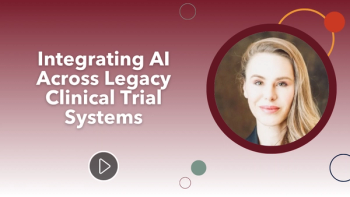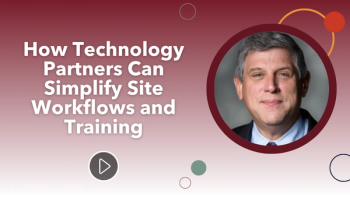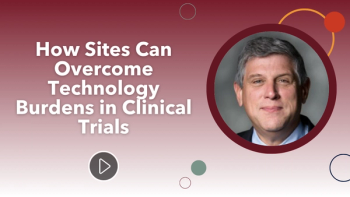
Applied Clinical Trials Supplements
- Supplements-03-02-2008
- Volume 0
- Issue 0
Steps to a Successful eClinical Program
EDC technology is only one component in the transition to a viable electronic existence.
To meet the challenges of the current climate in pharma, companies have initiated eClinical programs, which typically cover trial and data management, supplies, and biostatistics. A central issue in most eClinical programs is the implementation, use, and integration of EDC solutions. As its use is unavoidable in today's world, the agility and speed an organization shows in adapting to this technology is critical. Equally as critical in terms of a company realizing EDC's benefits: the planning involved, the necessary changes in both processes and organization, and the handling of the implementation of these changes.
PHOTOGRAPHY: JIM SHIVE ILLUSTRATION : PAUL A. BELCI
Forging ahead
An eClinical program is a collection of projects with the purpose of delivering a series of benefits to a company in a coordinated manner, rather than in an uncoordinated one, as completed, separate projects. The benefits typically include:
- Shorter time from Last Patient Last Visit to Database Release (DBR)
- Better quality of data with the use of fewer resources (e.g., significantly improved review and query processes and reduced errors)
- Faster access to results
- Better monitoring of trial progress
- Improved relationships with monitors.
These benefits are supported and enhanced by a series of projects/activities, working in cooperation with the EDC project, within the following three main operational areas of the eClinical program:
- People—organizational changes in departments, geography, and job roles
- Processes—SOPs and quality and government requirements
- Technology—standards, integration, and IT systems to support the processes and the people doing the work (of course, IT is very much a function of the first two areas as well).1,2
Operational issues
Technology. With technology, it's mostly a simple task of selecting between vendors by matching requirements for functionality, integration, and usability, and deciding on a strategy for hosting or having the system in-house. In dealing with the vendor, a few business-related arrangements are necessary in order to ensure successful EDC implementation, including:
- Agree upon the ramp-up speed from going live to full implementation, and follow up with the vendor about their manning strategy as the workload increases.
- Dedicate personnel to handle the practical issues with the vendor (in addition to selecting personnel to handle contractual issues).
- When selecting a vendor, make sure the terms for bringing in an application service provider solution are agreed upon at the project's start.
People and processes. When it comes to implementing EDC solutions, the biggest challenges in these two areas can easily be grouped together, since new processes affect people, and vice versa. These challenges include, but are not limited to:
- The transition from paper to EDC can be difficult; some sites may have reservations about EDC, given varied computer experience and high turnover among site personnel.
- Monitors have to adjust to a very different way of working (a faster turnover in queries and investigator questions, which must be handled by the monitor).
- A very large stakeholder group diverse in geography, professional area, and relationship to EDC makes the communication of the change very complex. The size and diversity of this group also make it difficult to target and meet the training needs of the different stakeholders. Besides this, the training must be scalable and it must be timely in regard to when the stakeholders first start using EDC.
- Change is hard, and new data management processes and functions must be introduced, especially related to the front-loading of tasks connected to data collection, cleaning, validation, and DBR.
- Since the new processes, roles, and responsibilities must be sustained from the time of full implementation of EDC, the organization is challenged not to revert to the same processes used with paper-based trials.
The way to deal with all these issues points back to one major eClinical program component: change management, which can mean the difference between whether an EDC implementation is successful or not.3,4
Change in phases
Explaining to all of the involved stakeholders the numerous changes that will be taking place with the addition of EDC, answering their questions, creating and executing the necessary organizational changes, initiating training, and communicating the impact such changes will have on the company is a major challenge in an EDC project. Thus, a structured and well-planned phase approach to change management activities throughout the project is essential.
Initiate and analyze. Consistent and sufficient communication to the right stakeholders (both internal and external) over time is critical for success. Stakeholders should be mobilized as sponsors, communicators, and change agents. A common vision should be developed, and an overview of the EDC benefits (both consolidated and for the different stakeholder groups) should be communicated.
In addition, the organization must ensure that the line of business management identifies and commits themselves to realizing specific EDC benefits in their respective business areas. It is important that all stakeholders are aware of what is new, what will change, what will stop, and how the organization, processes, and ways of working will be impacted over time. To work with the new processes and system, appropriate functions must be created during the "initiate and analyze" phase; this includes creating a project support organization.
Execute. In the transition phase, the line of business takes over the responsibility of the new processes and system. The handover from the project organization to the line of business and their support organization is often underestimated in terms of necessary resources and calendar time needed. It is recommended to introduce an overlapping period of three months for the handover—when the project support organization is still available for help and training. The focus should be on delivering support and flexible, effective training that's targeted to both internal and external stakeholder groups. It's necessary to update the stakeholder analysis and ensure all stakeholders are identified and receive timely training before each trial starts.
The EDC way of working should be encouraged internally and externally and achieved results should be made visible. One of the most visible and important changes in the planning phase of a study is the front-loading of tasks and decisions in trial and database set-up components. In the conduct and reporting phase, the most visible and important changes are:
- Front-loading of tasks connected to data collection, cleaning, validation, analysis, and DBR
- Workflow and interaction between international trial managers, data managers, statisticians, and medical writers
- Workflow and interaction between monitor and investigator
- Workload and roles of monitors and statisticians.
All these changes require a series of information and training activities to ensure successful EDC implementation and need to be included in the change management plan; a comprehensive change management plan should hold and be used to coordinate all activities related to all stakeholders, such as project participants, project end users, sponsors, etc.5
Realize. Anchor change and ensure that the changes are sustained. Following up on benefit realization is important—it needs to be shown that promised benefits are met, and if not, how to adjust the process to meet the promised goals. In this phase, a project very often slows down in regard to change management activities; however, it is here where follow-up is important to ensure that the new processes are being followed and really implemented in the organization.
Clear on EDC
Hopefully this brief overview of challenges, benefits, and the importance of change management has inspired you (if you haven't already been inspired) to look at EDC as a very important component—but not the only component—of a successful eClinical implementation.
With all eClinical projects, the most important part is to ensure a smooth implementation so that the solution provides the benefits promised, and the new processes, ways of working, and roles are accepted. More than half the budget for eClinical projects is spent in these areas.
Jette Klose,* MSc, is senior pharma consultant at NNIT A/S, Krogshøjvej 45, DK-2880 Bagsvaerd, Denmark, email:
*To whom all correspondence should be addressed.
References:
1. J. Aggerholm, "Linking People, Process and Technology," Pharmaceutical Executive Europe, March 2007.
2. R. Kush, P. Bleicher, S. Raymond et al., eClinical Trials: Planning and Implementation, (Thomson CenterWatch, 2003).
3. A. Sharp and P. McDermott, Workflow Modeling: Tools for Process Improvement and Application Development (Archtech House, Boston, 2001).
4. BPM Group, BPM Practitioner Programme, 2007.
5. R. Potts and J. LaMarch, Managed Change, LaMarch and Ass. (2006).
Articles in this issue
over 17 years ago
Text TRIAL to 85342 to Receive More Detailsover 17 years ago
SAE Reporting in EDC Trialsover 17 years ago
Going Electronic: Paving the Way for EDMNewsletter
Stay current in clinical research with Applied Clinical Trials, providing expert insights, regulatory updates, and practical strategies for successful clinical trial design and execution.






.png)



.png)



.png)
.png)
